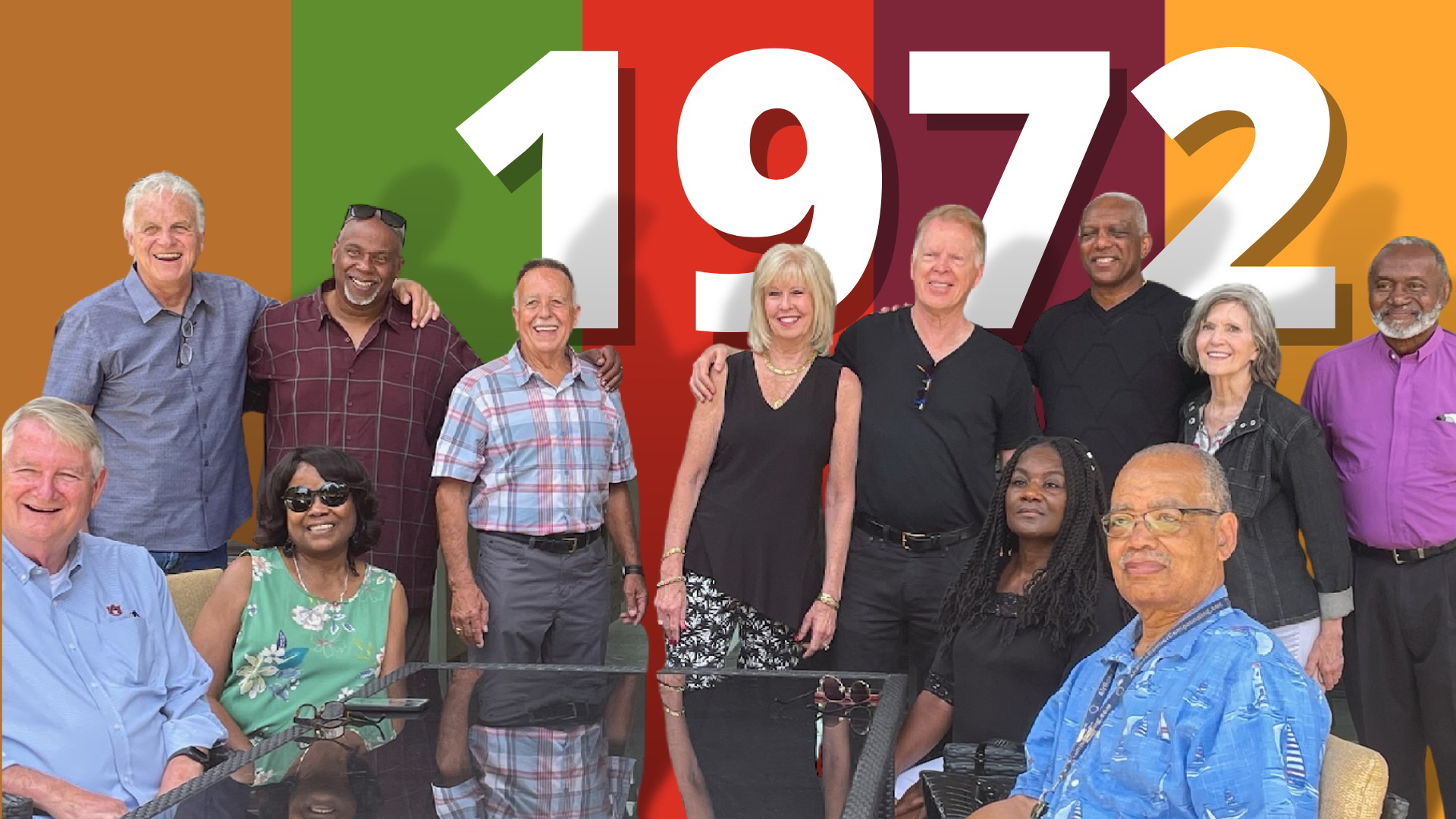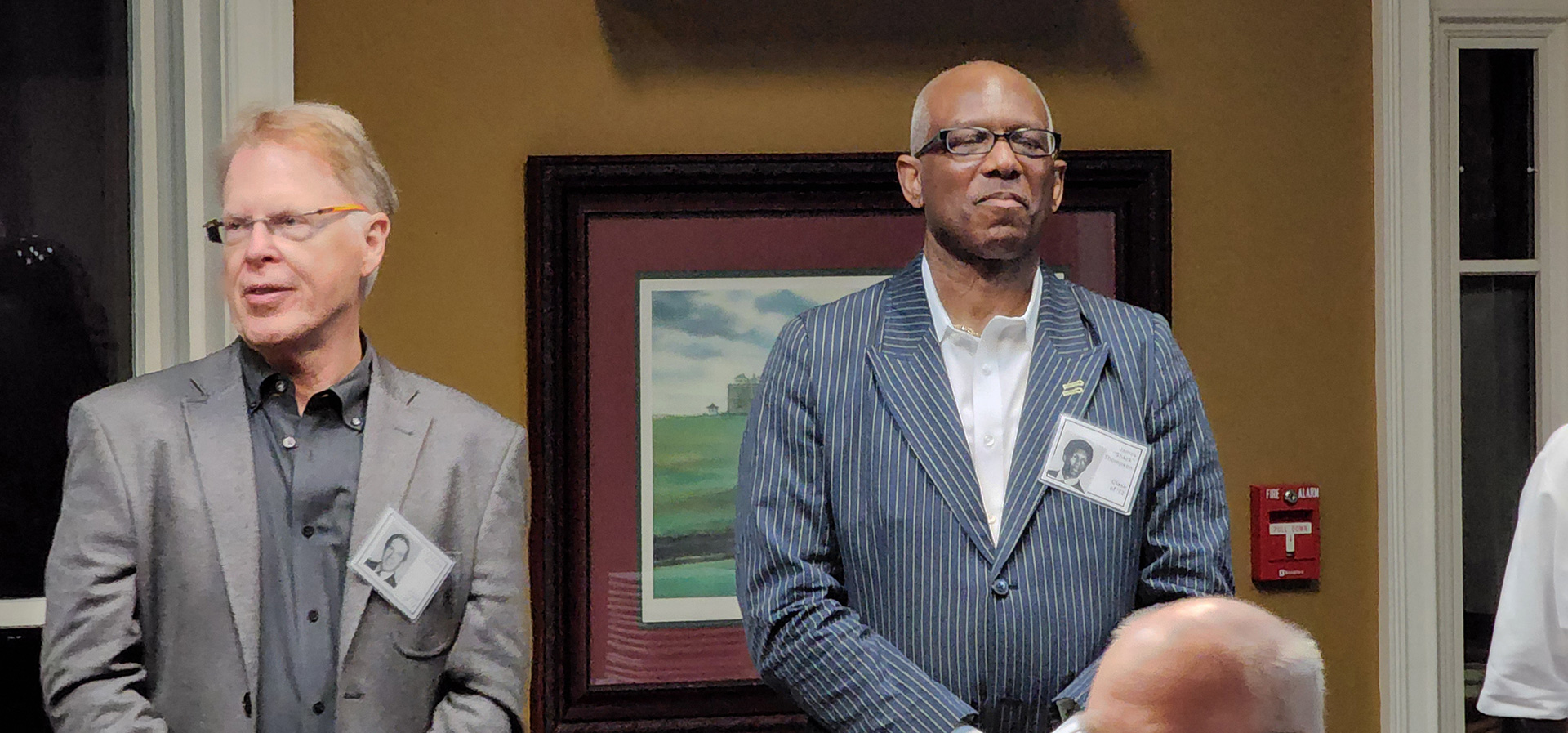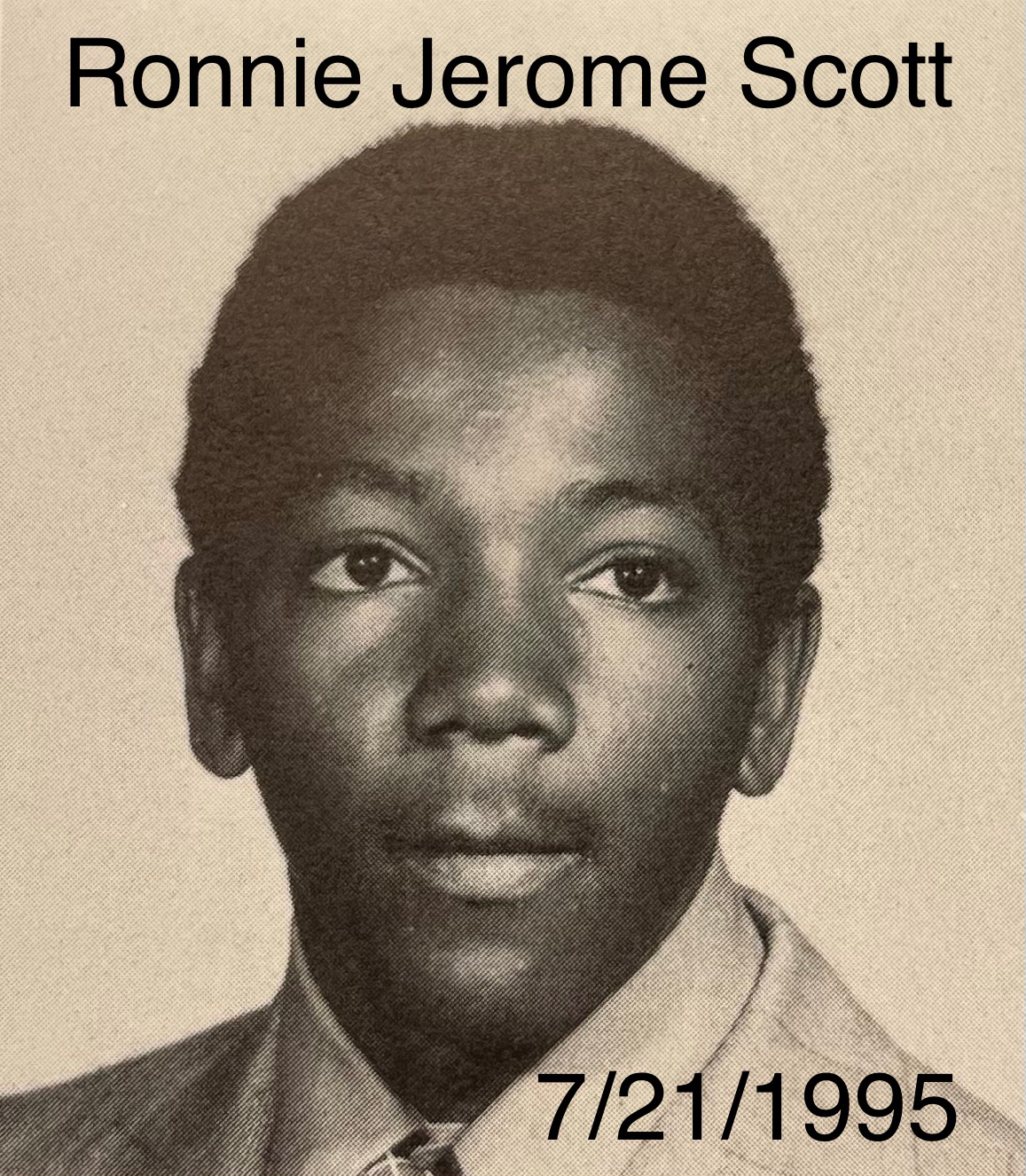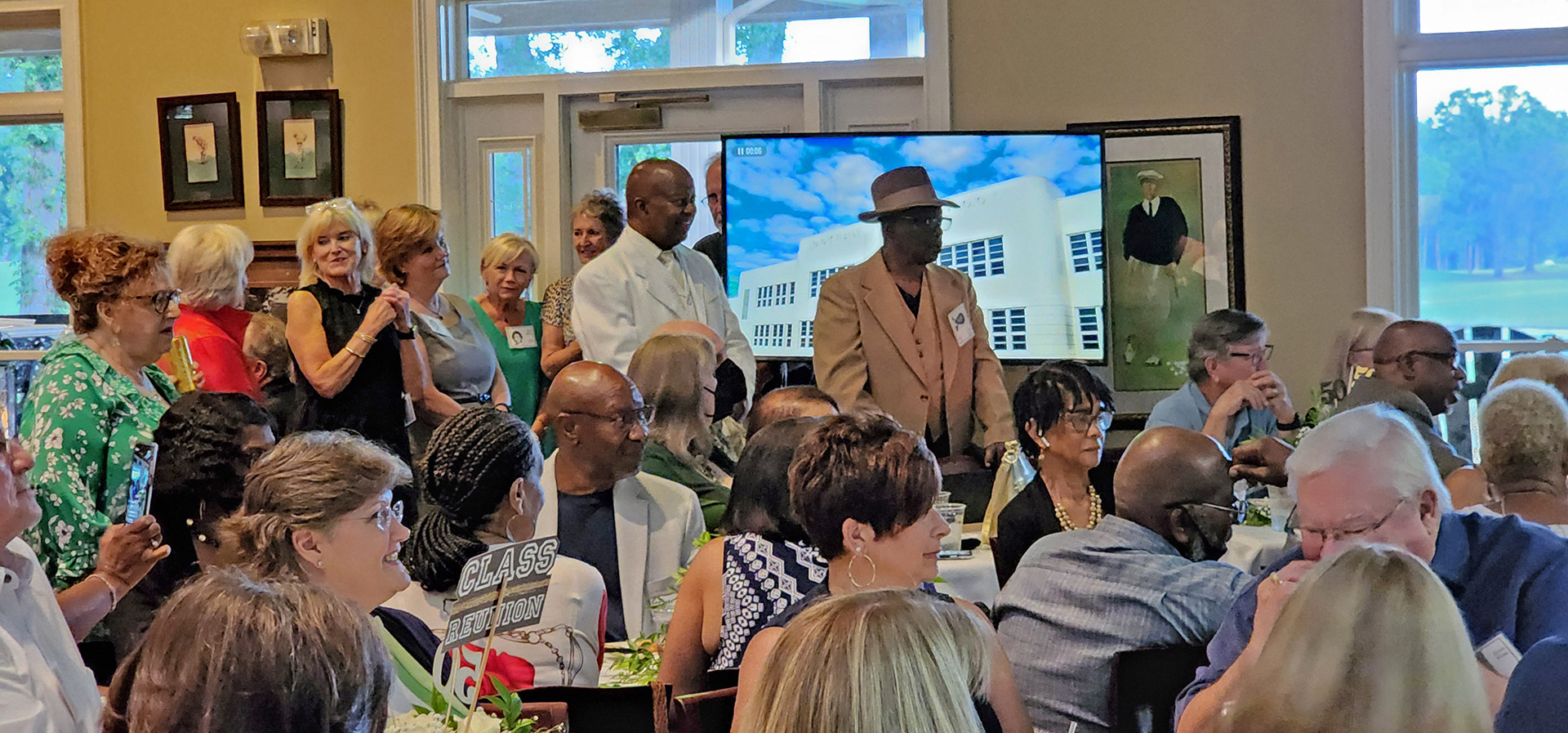
The Elephant in the Room
In 1969, the year Charles McNair entered the 10th grade, the Dothan, Alabama, public schools finally integrated. This year, the Dothan High Class of 1972 held its 50-year reunion, where joyous, authentic and honest conversations happened across the lines of race.
Ronnie Scott could run.
I found out how fast in a 50-yard foot race during the first weeks of 10th grade at Dothan High School in southeast Alabama.
We took P.E. together. Black Ronnie. White Charles.
In fall 1969, kids like us suddenly found ourselves together in classrooms and gyms and on playing fields for the first time in our lives.
Dothan had finally complied with the landmark 1954 Brown vs. Board of Education ruling by the United States Supreme Court. It held that state laws creating racially segregated schools were unconstitutional. With all deliberate speed, 15 years after the decision, our school board shut down the city’s all-Black high school, Carver, only weeks before my first year of high school.
Now, every Dothan 10th, 11th and 12th grader, Black and White, female and male, crowded the corridors of Dothan High School.
Confusion isn’t a strong enough word.
Fifty years later, it seems like a devil’s plot that our first year of integration came at the culmination of the great collective national nervous breakdown called the 1960s.
The tensions of Vietnam and the Civil Rights Movement and the counterculture and the assassinations and the Cold War had run through us all that tumultuous decade.
Now, at childhood’s end, seething with hormones and history, we entered high school.
~~~
Looking back, one wonders how many people really held faith that integration in Dothan would succeed.
For the first weeks of the new school year, a TV reporter with a camera showed up in the parking lot expecting 6 o’clock news to break out. Some parents enrolled their kids in private schools. What happened in faculty meetings between Black and White teachers was anybody’s guess. I heard about one or two fights, though I never saw one.
All of us sort of held our breath.
As we did — as the United States integrated Dothan High and other schools — the entire world looked on in fascination. No social experiment on this scale and scope had ever been attempted in the land of the free and the home of the brave since the murderous Civil War, a conflict that ended the kind of slavery you could see.
Now came this newly pivotal moment in American history — and the pilot program for fixing inequity between races would be an effort placed mostly on the backs of children in schools and on teachers and administrators.
I walked into 10th grade classes at Dothan High School like more than 400 other students, Black and White. We would come of age together through three years of high school.
It was high time, he passionately insisted, that our Black classmates lay claim to their three years of high school as their own history. To fill a blank space. To own what was theirs, what was earned, won, rightful.
It never occurred to most of us then that we were part of history.
We had bigger worries.
Crushes. Pimples. Identities.
Footraces.
Let’s race, I challenged Ronnie Scott at the end of that first-period P.E. class five decades ago.
We’d been playing touch football. A Black team captain chose mostly Black players and a White captain chose mostly White ones. It seemed natural to me, not racially freighted, that captains chose athletes whose skills they knew from their neighborhoods or school yards.
But, of course, the scrimmage had an edge. Black players wanted to prove themselves, athletically. So did White players. Every playing field is a crucible for young males. Silly games matter. Males get competitive.
Ronnie Scott sized me up.
Mac, you want to race me? I’ll burn yo ass!
Ronnie was scrawny, all elbows and knees, his white T-shirt too big. I could outrun any kid that skinny.
The whole P.E. class looked on.
On your mark! Get set! Go!
Ronnie Scott was two strides ahead of me before I moved. He flashed past the finish line five yards ahead in a 50-yard race.
Yes indeed. Ronnie Scott burned my ass.
~~~
Nearly 50 years later, living in Atlanta, deep into a career as a writer, I got a call out of the blue from James “Shack” Thompson, another Dothan High School classmate.
Shack is Black. He’d been in that same 1969 P.E. class. We graduated together three years later, Seniors ’72. He had been more of a high school acquaintance back then than a friend, but Shack always had gravity, charm, a presence.
Shack was in Atlanta. He wondered if I had time for a cup of coffee.
I invited him to my house on Seminole Avenue, and we caught up on four-plus decades of twists and turns, the unspooling paths of two lives. Shack lived far from Dothan now, his home in King of Prussia, Pennsylvania, north of Philly. He’d settled there after a career as a teacher then FBI agent. Now he kept busy writing and making films, and he occasionally took acting roles in those healthcare commercials you see on national TV.
Shack proudly showed me pictures of his beautiful wife and his handsome son. I showed pictures too, and I hinted to him I might soon move to Bogotá, Colombia, to start life over at age 60 with a remarkable woman I’d met.
Our cordial meeting became a bonding one. And before we parted that afternoon, Shack surprised me with a challenge far bigger than the challenge I once gave Ronnie Scott.
Shack explained that, since graduation, our every-10-years class reunions for the Seniors of 1972 were mostly segregated. The White classmates came, the Black ones stayed away. Too many Black students still nursed a great grievance, Shack said — they never truly felt included. When Dothan closed Carver High School, the result wasn’t a welcome embrace by a bigger school. It was a diaspora, a class set adrift from roots and history, taking refuge in foreign Dothan High classrooms.
Shack had a dream. He wanted to fix this.
It was high time, he passionately insisted, that our Black classmates lay claim to their three years of high school as their own history. To fill a blank space. To own what was theirs, what was earned, won, rightful.

Our class was historic, Shack pointed out — the first in Dothan High School history to graduate fully integrated through all three years of high school.
The date for our 50th high school reunion lay just ahead, in 2022.
Shack asked me to help him bring folks together for that reunion. To change some hearts and minds.
He changed mine that day.
~~~
Who was I in high school?
Memories linger like old 1970s videos, colors faded.
There’s Charles McNair, hopelessly chasing fleet Ronnie Scott down a playing field.
There’s Charles McNair playing “The Tonight Show” host Johnny Carson at an induction event for the National Honor Society with the whole high school, 1,800 Dothan High Tigers, looking on and laughing.
There’s Charles McNair, editing Scribbler, our high school literary magazine.
There’s Charles McNair, skipping the 10th grade prom because he couldn’t take the girl of his dreams … then skipping the 11thgrade prom and the senior prom because he still couldn’t take the girl of his dreams.
Charles McNair lived in a White bubble. Blissfully naïve. Fatuously untroubled about race or most anything else that wasn’t edible … or the girl of his dreams.
I perceive that many of us lived that way those years, in White bubbles and Black bubbles. We bounced through the school corridors, in and out of classrooms, our bubbles passing close enough to let us see one another inside but never really connecting. We floated past in daily currents, bustling, joshing, mouthing every-now-and-then hellos. Truthfully, our interracial contact wasn’t even skin-deep.
That would change. Care would come. But it would take 50 years.
~~~
Who finds it easy to reject the beliefs of every trusted adult and figure of authority you have ever known?
As I grew up, Dothan was the heart of George Wallace country. The politician from nearby Barbour County rose to national prominence exploiting race — segregation now, segregation tomorrow, segregation forever, he declared, standing in a schoolhouse door at the University of Alabama, where I would attend classes after high school.
Everything and everyone around him had indoctrinated young Charles McNair into Wallace World. Bigotry started with the first nursery rhyme, Eenie Meenie Miney Moe, catch a n***** by the toe, and from there every social structure — family, church, school, baseball league, swimming pool, everything everywhere — reinforced the separation of races.
It took me years to delete the bad code and move along. It took years to even recognize the true depth of my indoctrination. Then it took wrenching decisions to defy it — and to see how all those structures supported it — even knowing bone-deep that inclusion was completely, morally, spiritually, undeniably right.
I have found cause ever since those days — and that Charles — to put a little extra into righting old wrongs.
That’s why Shack’s call for a 50th high school reunion to unite Black and White Dothan High classmates spoke powerfully to me.
A half century wasn’t too late for a unity reunion, was it?
~~~
We planned for 18 months before our 50th reunion.
Eighteen people, Black and White, gave their time and commitment to designing the event. Some committee members had day jobs; others had retired. Some of us still lived in Dothan. Others, like me, were scattered to the world.
We held a monthly Zoom call, a combination pep rally, gossip gathering and planning event. We issued monthly letters to class members, many notes jointly written by Black and White classmates. We pushed to find missing class members, determined to invite everyone ever part of the class, whether or not they got diplomas. We pushed through COVID, grimly watching the list of deceased classmates swell. One of our Black committee members, a star basketball player, died. From a graduating class of over 400, we would ultimately honor 84 dead.
Ronnie Scott was among them.
That news came as a sudden shock. It came during a moving commemorative montage created for the reunion. Somberly, 200 living classmates who attended the reunion saw, one by one, high school yearbook photos of all those we’d lost.
Near the end, Ronnie Scott’s face appeared on the video screen.

My eyes filled. I remembered out of nowhere the opening lines of a poem, “To An Athlete Dying Young,” by A.E. Housman.
The time you won your town the race
We chaired you through the market-place;
Man and boy stood cheering by,
And home we brought you shoulder-high.Today, the road all runners come,
Shoulder-high we bring you home,
And set you at your threshold down,
Townsman of a stiller town. pp
Skinny, swift little Ronnie Scott had left me behind. Again.
~~~
Always, all my life, there was an elephant in the room whenever Black and White people met.
The shadow of the blasted thing fell across the tables in corporate meetings, in elevators, on work crews, at sporting events. Nobody mentioned the elephant, but it was always there.
The Race thing.
Put in the same room, Black and White people turned unnatural. They stopped being their true selves. They put up shields and tiptoed around topics. For every word said, many more were swallowed.
That ended for me in June 2022.
The 50th high school reunion of the class of ’72 was a triumph.
On Friday and Saturday, June 10-11, from 6 p.m. till a late hour when feet gave out, classmates and families mixed and mingled 50 years after graduation.
Black and White.
Some danced, some leaned on canes. Some sang with the band, some sat with oxygen tanks and breathing tubes. Class members showed up blind and halt and lame, gray-haired, white-haired, bald, bewigged. And we talked openly the way we should and could have been talking for 50 years. Authentically. Honestly. Heart to heart. One soul to another. Friends.
Differences acknowledged. Differences immaterial.
Asked to say a few words, our class president simply blurted out, “My heart is so full!” Emotion overcame him. He struggled to say more.
Many of us never touched the banquet tables piled with food — instead we passed reunion hours hugging, shaking hands, meeting anew, catching up. We celebrated the life we still held in our 68-year-old bodies. We made ourselves busy forgiving and forgetting once and for all whatever foolishness ever divided us.
We met with the joy of survivors, the exhilaration of youth magically rekindled for a few precious hours. We laughed at adventures and misadventures. We spoke caringly, with perceptions earned through enduring everything five decades could throw at us.
A little wisdom lingered in the ballrooms.
But no elephant. Not those nights. And just maybe never again for the Seniors of ’72.
In my life, there was always an elephant in every mixed room.
Until there wasn’t.
If this kind of honest, loving unification can happen in Dothan, in the pine-knot heart of Wallace World, why not anywhere?
Why not everywhere?




I was a 5th grader in Charlotte NC in 1970. I rode a bus every day to the Black school in West Charlotte. The following year, our family moved to rural Georgia and I was enrolled in one of the many private schools that popped up around 1969.
I think about that 5th grade year at University Park Elementary often, and last year made contact with a friend I made on the other side of town in 1970. He remembered me.
So much of this story is the same for so many of us. The indoctrination, the slow process of escaping it, the even slower process of realizing the depths of it. And unfortunately that’s just half of the story.
Thanks for reading my essay and for the remembrance of your own. c
What a wonderful essay, Charles. Thanks for introducing me to Shack Thompson!
Thanks right back to you, Bill, and doubly for running Shack’s own remembrance in The Dothan Eagle. You manage a good newspaper, Bill. You’re a lighthouse keeper of liberty. Keep up the good work. c
Four years behind you, it was ’68 when I graduated in Decatur (AL), the first year of integration and there were only two people of color in my class. Thank you for this poignant reminder of those strange days of residual rage on every side.
Thank you for making time in this, the only life you have, to read my essay. I’m grateful. c
Charles, this was a beautiful story. Thank you for sharing it. Janet M . Stovall
Muchas gracias, Janet! Hugs from the high Andes! c
I felt your pain and joy Charles. This piece is a wonderful example/reminder of what our world should, and can be! Thank you, Hugh Hunter
Thank you! Thank Hugh! c
Thank you, Charles. I am wondering about your classmates’ experiences these 50 years. What led them to comfort and wisdom about race?
My school in Charleston desegregated during 1966-67. I was in 7th grade. At first, it was like there were two distinct schools, one Black and one White, using the same building in parallel. But the Black students came from their all-Black school to our previously all-White school without their teachers, administrators, traditions, books, or parent volunteers. It was as if the kids were airdropped in to continue their school life in this new place, minus all the adults who knew and loved them and without their former name, school colors, songs, mascots, teams, or clubs. Our academic classes were “tracked,” resulting in only one Black student being included with the college prep White kids. Clemon was sweet but shy. The White boys would tease him. They called him Kingfish. He would respond with a generous smile but keep to himself. He stayed with us in that track all along the years, always smiling, but he must have been lonely.
By the time we reached 10th grade, there was another scramble. We were moved to a new, unfinished building in the middle of nowhere, just for grades 9 and 10. There were no sidewalks, no grounds. It was too muddy for the buses to get close to the school, so we had a long ride on the highway followed by a bit of a hike on foot to start each day. There was no cafeteria either, so we queued up to receive a shrink-wrapped honey bun and a bag of chips for lunch each day and then were shuffled into a tiny courtyard for recess. It was a completely bare place, just a mud-filled yard surrounded by buildings on four sides. No trees or benches, we just stood there. A guy with binoculars was always there, too, surveying us from the school roof. Looking for drugs to pass from hand to hand, we thought. We felt like prisoners. There was not much trust-building going on among students, either, and that year ended badly. Just before summer break, at dismissal one day there was a teenage race riot (mostly boys) along the long road we had to walk to reach the buses after school. Tiny (White) English teachers, untrained for this professional obligation, waded out into the middle of it, trying to take away weapons. The narc with the binoculars was nowhere to be seen. I think he was using the opportunity to rifle through lockers inside.
That arrangement only lasted one year. We returned to our previous school building, the “junior high,” for our junior and senior years. Academic classes were somewhat more integrated, which was awkward given the recent history.
Then a crisis. Several White students were arrested at school for drug distribution. It was not their first or second time, and they were headed to prison. Having nothing to lose, at least in their adolescent minds, they broke into the school one night, poured mimeograph fluid everywhere (remember that stuff?) and lit a match. We gathered on the lawn the next morning, and some kids cried. It felt personal. School was closed for cleanup for a long while, then we returned to a smoke-scented building. The library upstairs was unusable; the floor was unstable. When we opened our lockers that first day back, water from the firefighters’ hoses flooded the floor. Our trophy case and all its contents had melted.
So, we started over. We voted on a new name for our school, a new alma mater, new colors and mascot. We had regular all-school meetings in the gym for updates. From then on, pep rallies, student government, and clubs were completely integrated by race. We elected the son of a Black Presbyterian minister as our student body president. Tellingly, our sense of ourselves as progressive reached a peak, however, when we voted to add boys to our cheerleading squad.
Our reputation as a model of successful integration grew, and the kids in student government were called on to give presentations at the district level to explain. We said it was because of the fire. We got to define ourselves. We designed our school together, and while not a utopia, we genuinely felt it belonged to us, and we belonged to each other.
Thank you for sharing this story, Ann. Charles’ story has engendered a lot of good conversation, and I’m happy that you’ve kept the conversation going with your story.
Ann, this story belongs to me now too, the way you belonged to one another at your school. Thanks so cutting yet another facet onto the monolith we’re reshaping now. c
Wow, this story resonates so much for me! I started high school the fall after you graduated, Sept 72. My class was the first one to complete all 3 years under the court-ordered bussing as it was called. My experiences parallel yours in many ways, with a difference being that my parents actively believed in the integration project. I must admit that I still don’t know if a Black school was closed, or if district lines were just redrawn. I do know that teachers, as well as students, were shuffled to create an integrated staff along with an integrated student body, so the whole place was uneasy, unsettled. There was a new principal (white) and assistant principal (black), and they provided good leadership. It probably helped that each of them had daughters in my class. All our student clubs and activities were monitored and manipulated to maintain racial parity: cheerleading squad half and half, one year homecoming king and queen a Black pair, with Mr and Miss CHS white, the next year vice-versa and so on. We students voted, of course, but the staff made the ultimate choice. I do think all that stuff helped, but what we never got was a chance to talk about what was going on. And we white students were so ignorant! What every Black child knew, and no white child understood, was that our school, the town’s first and oldest high school, had been moved out of its original building and into the building we attended in 1963 as an early feint in the maneuvering to avoid the integration mandate. The original building was renamed and became a Black high school, a hand-me-down school to keep the town’s flagship school white. Black kids coming in to CHS understood from the get-go that they were changing with their presence a school that the city had tried to keep them out of, but white kids were SO CLUELESS. It has taken me my whole adult life to wrestle through this. How much better if we had been able to talk at the beginning. But while there is breath there is life, right? Never too late to start a conversation.
An author who spins authentic yarns about life. Every story is a delight. It is a blessing to count you as friend.
Many thanks to each of the wonderful reflections to collaborate and confirm Charles’ wonderful essay. It was Charles who encouraged me to write my essay and recollections too. Charles is an excellent writer, a better friend, and a man whose mid-life epiphany caused each of us to have our own reawakening. Percy B. Shelley said that poets are the unacknowledged legislators of the world and writers use their hands to change the world. Charles is one of those miracles! Thanks, James “Shack” Thompson
You guys have done some good, for sure, and so’ve all these other comments. Appreciate y’all.
PS: Charles, I can’t seem to post a comment on the other piece about your mom, but among the many hard and glittering things about it that I love, and that resonate with me, the smallest, clearest thing I have to complement you on is the verb in this phrase: “lightning bugs seltzered the night.” Oh, how I seek and savor that kind of stuff!